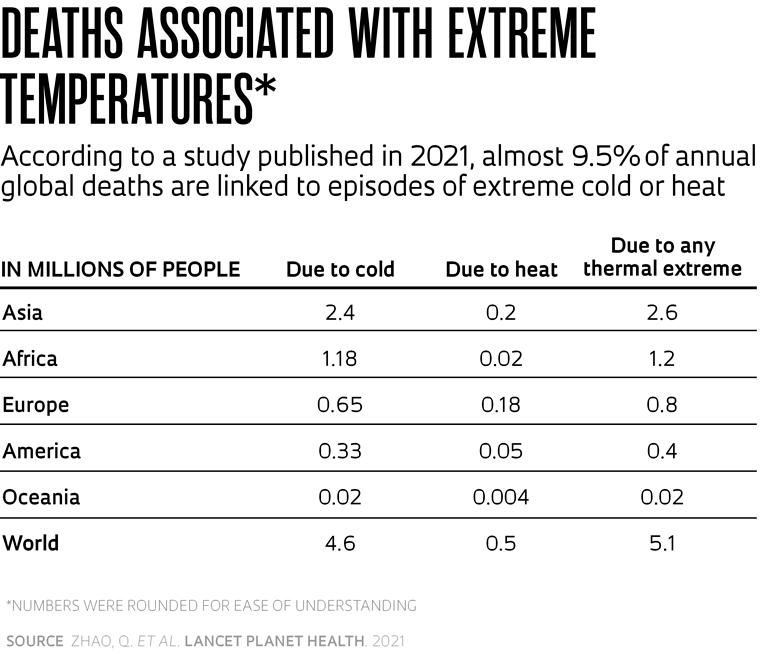The heatwaves of the European summer in 2022, similar in intensity to those now occurring once again in the Northern Hemisphere, were responsible for the deaths of 61,600 people between the end of May and the beginning of September last year, most of them elderly people and women. This was the main conclusion of an article published in the scientific journal Nature Medicine in July 2023.
The Mediterranean countries were the hardest hit. There were 18,000 and 11,300 deaths respectively in Italy and Spain, according to the study. “The Mediterranean is affected by desertification, heatwaves are amplified during summer just because of these drier conditions,” Spanish climatologist Joan Ballester of the Barcelona Institute for Global Health, lead author of the study, told Reuters.
However, in Germany, which has a temperate climate, the impact of the heat was also significant: 8,100 people succumbed to temperatures that hit 40 degrees Celsius (°C).
— July was the hottest month in recent history and broke temperature records
— Urban heat islands make even small and midsized towns warmer
The number of deaths in Europe, one of the richest regions of the planet, is extremely high due to episodes of intense heat. One important factor is that a significant proportion of Europeans are aged over 65, making them more vulnerable to temperature variations, and that historically they are better prepared for and used to dealing with the rigors of cold weather, rather than suffocating heat and forest fires of blistering summers. The number of annual deaths worldwide associated with extreme temperature fluctuations — both above and below the zone of greatest thermal comfort to humans (between 22 and 26 °C) — is in the order of millions, putting the number of fatalities in the European summer in a different perspective.
There is no consensus on the global number of deaths associated with sudden or significant temperature changes. Studies based on different methodologies attribute different mortality figures to the rise and fall of the mercury. An article published in Lancet Planet Health in 2021 calculated that five million people die every year due to sudden or significant temperature variations, representing 9.5% of all deaths worldwide. Just over three-quarters of the victims live in Asia or Africa (see table). Around 10% of deaths occur due to excessive heat and 90% due to cold.

An epidemiological study by a group from the Institute for Health Metrics and Evaluation at the University of Washington, USA, estimated that 1.7 million people died as a result of extreme temperatures in 2019. The results were published in Lancet in August 2021. The article estimated that thermal fluctuations caused approximately 17,300 fatalities in Brazil, two-thirds of which were associated with cold and one-third with heat.
A third, even more recent survey, published in May last year in Lancet Planet Health, calculated that between 2000 and 2019, just over 1.7 million people lost their lives per year due to significant temperature changes. The study was led by an Australian team from Monash University. Regardless of which study is most accurate, one central, common theme is that too much heat or cold kills millions.
Paulo Saldiva, a pathologist from the School of Medicine at the University of São Paulo (FM-USP) and coauthor of the two studies published in Lancet Planet Health, believes public health professionals need to consider climate forecasting as a variable that influences their practice. “Agriculture has long made plans based on climate variations — whether it will rain more or less, whether it will be hotter or colder,” says Saldiva. “The health sector needs to do the same.”
Children and the elderly suffer most from extreme cold and heat
He cites São Paulo as an example. During the top 2% of the hottest days of the year, there is a 50% increase in the number of deaths in the city. Instead of 200 deaths a day, there are 300. People often feel suddenly unwell due to high temperatures, which are sometimes accompanied by low humidity and almost always by high levels of air pollution.
Adverse thermal conditions interfere with the human body’s metabolism, altering cardiovascular, renal, and blood pressure control functions, in addition to the levels of hormones such as cortisol and thyroid. Peripheral veins dilate, potentially causing dizziness, and the heart starts to beat faster. “Children and the elderly are most at risk,” says the pathologist.
Death is the most extreme result of major thermal discomfort. Other more subtle effects may have less of an impact on quality of life but can lead to material losses. In an article written in partnership with the group from Monash University and published in Science of The Total Environment in May, Saldiva and his FM-USP colleagues estimated that economic losses generated by working in inadequate thermal conditions (too hot or cold) totaled US$105 billion in Brazil between 2000 and 2019.
The study analyzed indicators from 510 areas of the country and associated them with deaths and lower productivity. Men aged 15 to 44 suffered the greatest decline in labor output as a result of extreme temperatures. In southern Brazil, extreme cold was the thermal discomfort with the greatest impact. In the Northeast and Midwest, it was intense heat.
An article published in the journal Science in May estimated that the climate phenomenon El Niño (when warmer surface waters in the eastern Equatorial Pacific alter global rainfall and temperature patterns) causes major losses to the global economy. The 1983–1984 El Niño was associated with worldwide losses of US$4.1 trillion and the one in 1997–1998 resulted in losses of US$5.7 trillion, the equivalent of 20% to 25% of the American economy. Given the situation we are facing with regard to climate change, the authors of the paper project global losses of around US$84 trillion due to El Niño events over the course of this century. This is yet another serious reason to take climate change into account when it comes to social and health issues.
Scientific articles
WEN, B. et al. Productivity-adjusted life years lost due to non-optimum temperatures in Brazil: A nationwide time-series study Science of The Total Environment. vol. 873. may 15, 2023.
CALLAHAN, C.W. & MANKIN. J. S. Persistent effect of El Niño on global economic growth. Science. vol. 380, no. 6649. may 18, 2023.
WO, Y. et al. Global, regional, and national burden of mortality associated with short-term temperature variability from 2000–19: a three-stage modelling study. Lancet Planet Health. vol. 6, no. 5. may 2022.
BURKART, K. G. et al. Estimating the cause-specific relative risks of non-optimal temperature on daily mortality: a two-part modelling approach applied to the Global Burden of Disease Study. Lancet. vol. 398, no. 10301. aug. 21, 2021.
ZHAO. Q. et al. Global, regional, and national burden of mortality associated with non-optimal ambient temperatures from 2000 to 2019: a three-stage modelling study. Lancet Planet Health. vol. 5, no. 7. july 2021.


